Abstract
A method is described for the simultaneous purification of milligram quantities of complement components C2 and Factor B. Both products are homogeneous by the criteria of polyacrylamide-gel electrophoresis and N-terminal sequence analysis. Component C2 is cleaved by serine proteinase C1s at an X-Lys bond to give fragment C2a (approx. mol.wt. 74000) and fragment C2b (approx. mol.wt. 34000). The two fragments can be separated by gel filtration without the need for reducing or denaturing agents. Fragment C2b represents the N-terminal end of the molecule. Similar results were seen on cleavage of Factor B by Factor D in the presence of component C3. Again two non-covalently linked fragments are formed. The smaller, fragment Ba (approx. mol.wt. 36,000),) has threonine as the N-terminal residue, as does Factor B; the larger, fragment Bb (approx. mol. wt. 58000), has lysine as the N-terminal residue. A similar cleavage pattern is obtained on limited proteolysis of Factor B by trypsin, suggesting an Arg-Lys-or Lys-Lys bond at the point of cleavage. Although component C2 and Factor B show no apparent N-terminal sequence homology, a limited degree of sequence homology is seen around the sites of proteolytic cleavage.
Full text
PDF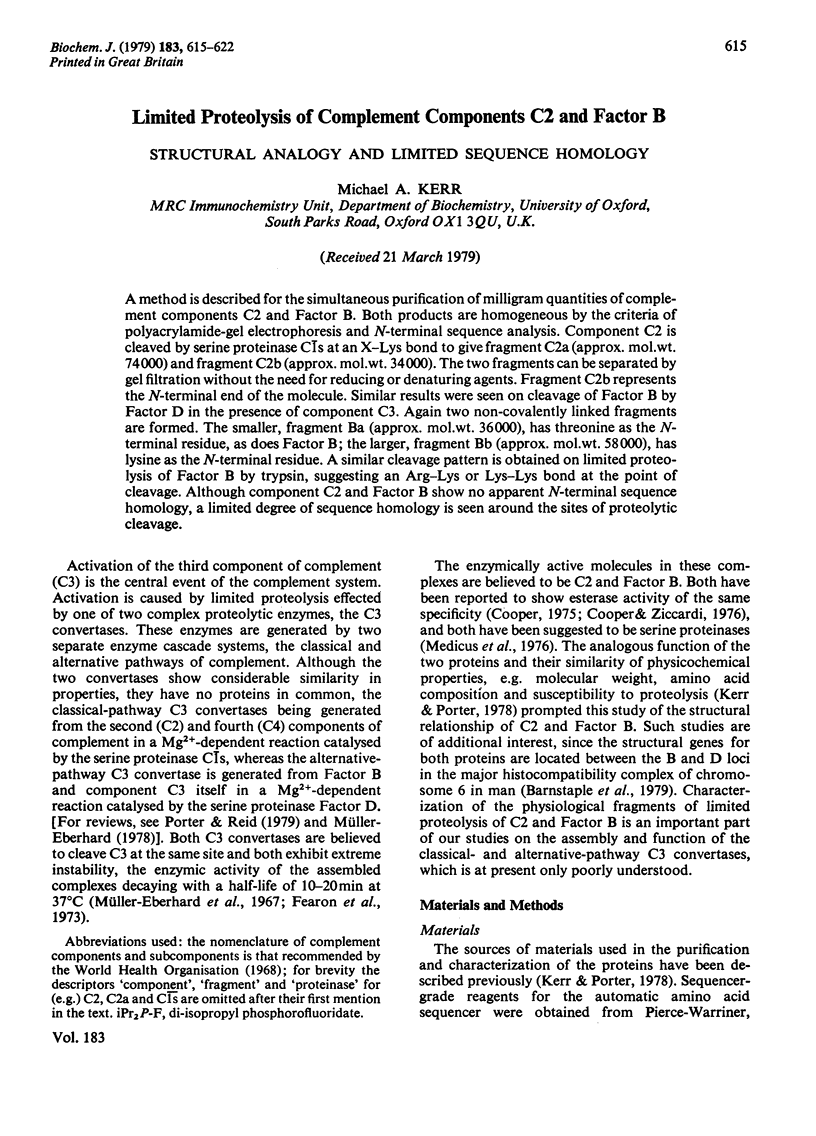
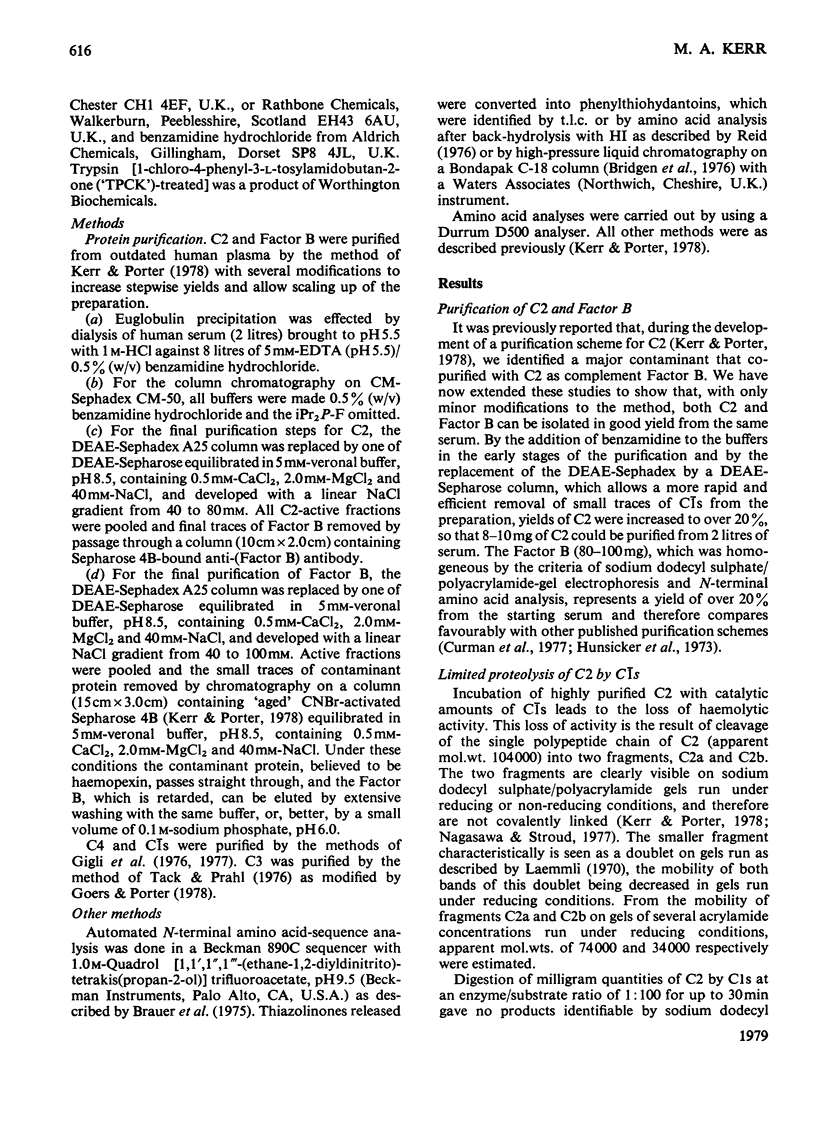
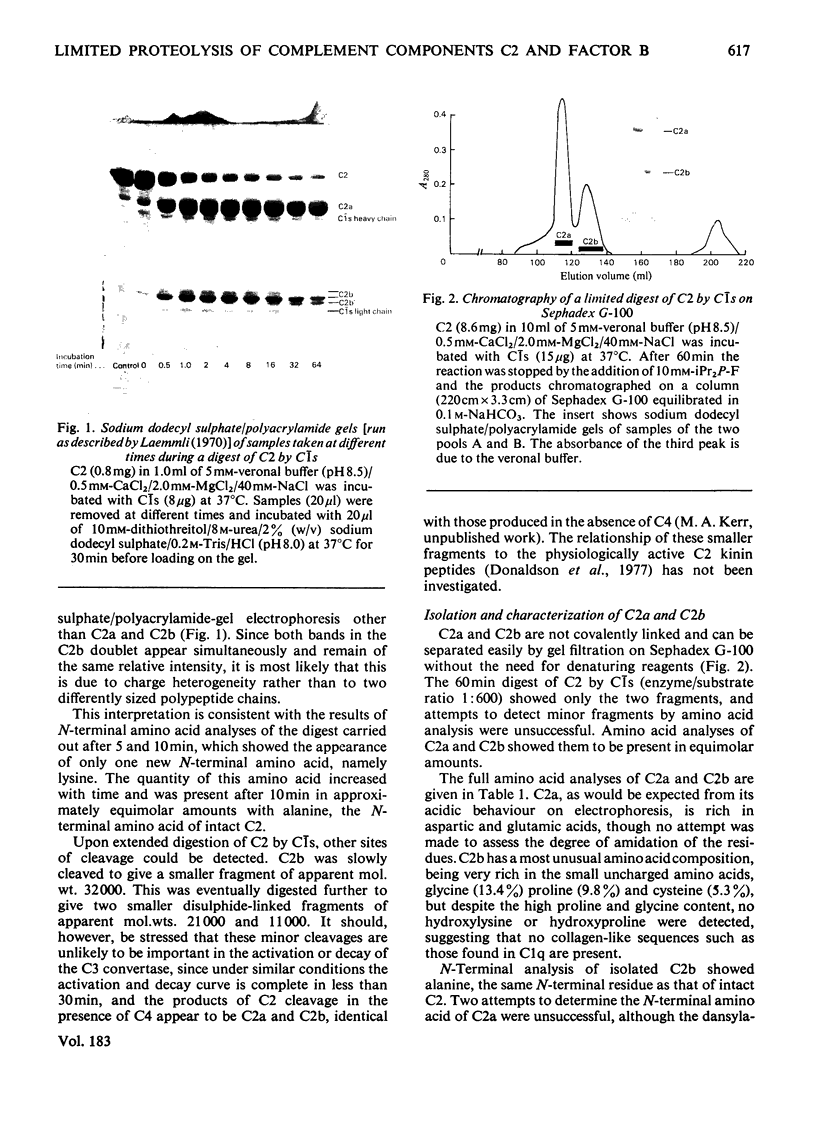
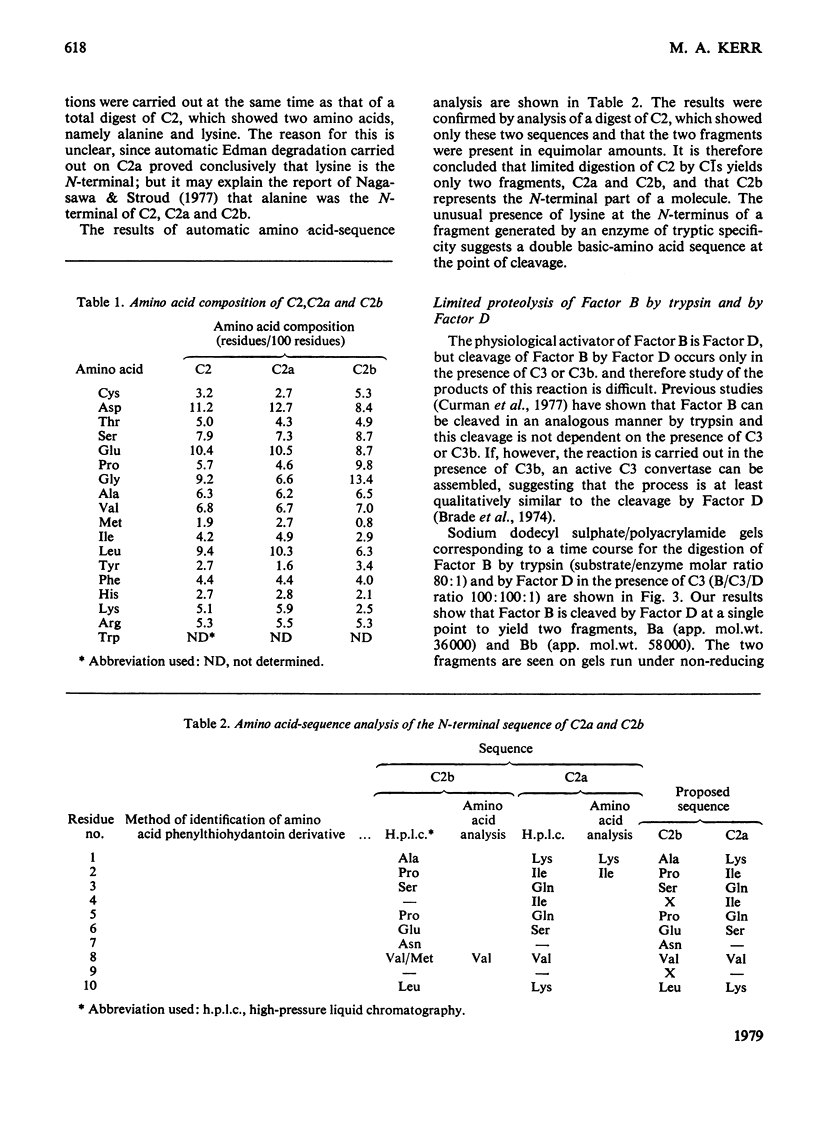
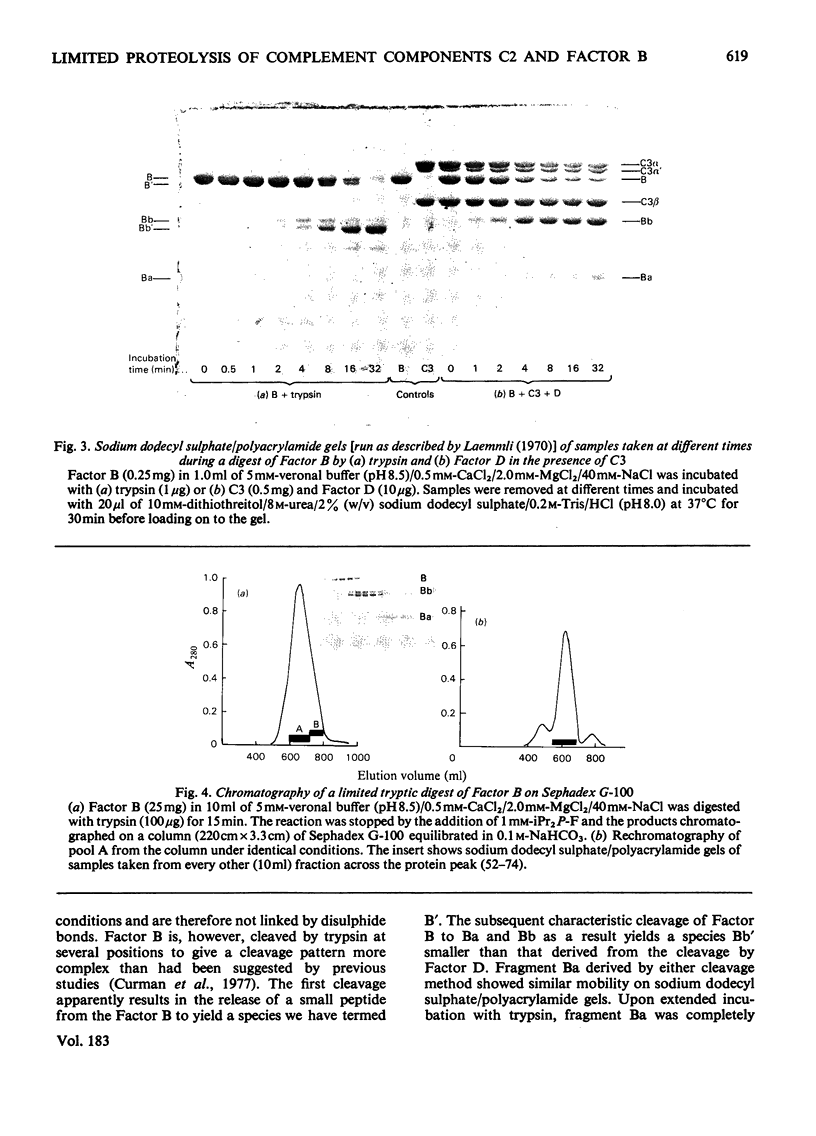
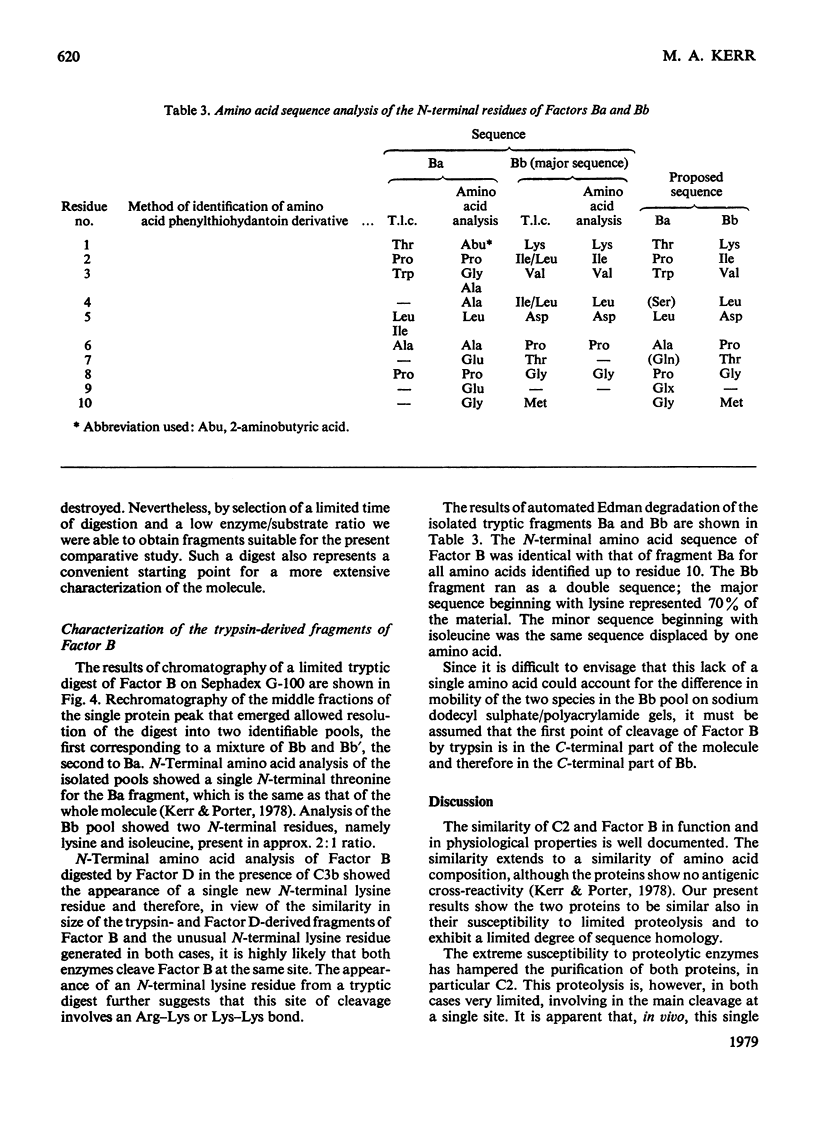
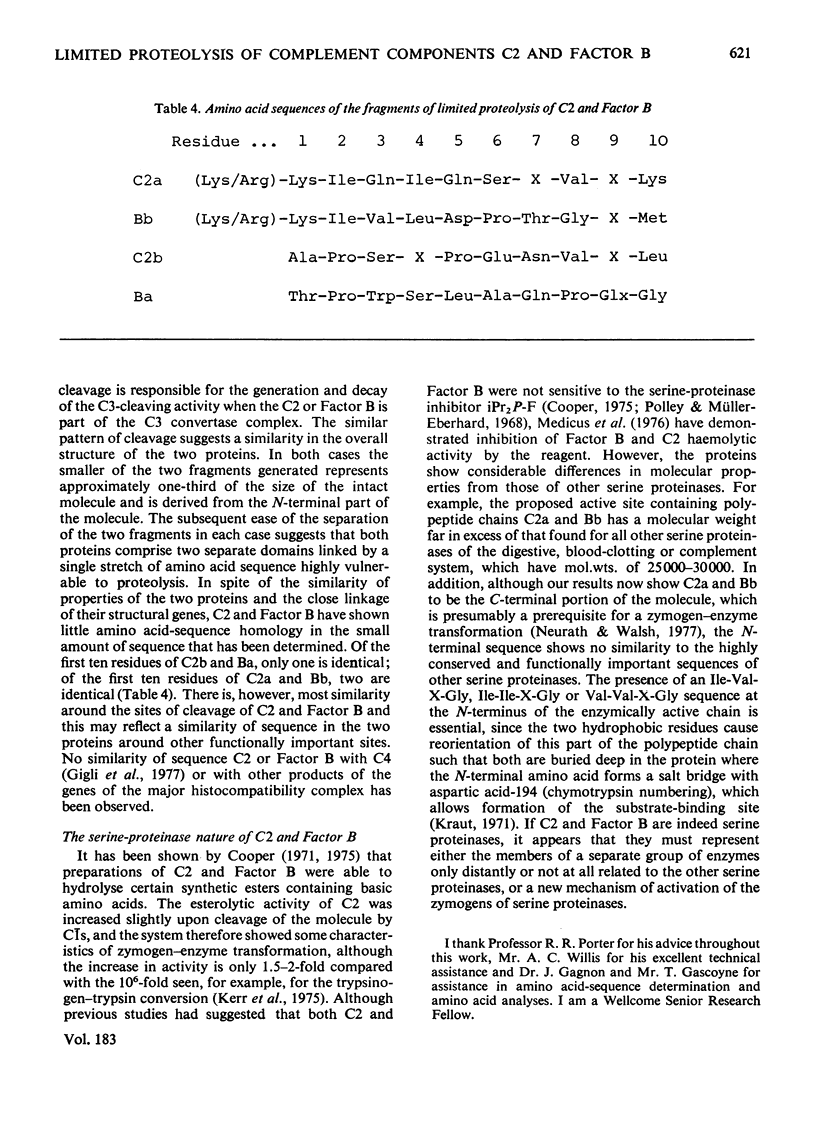
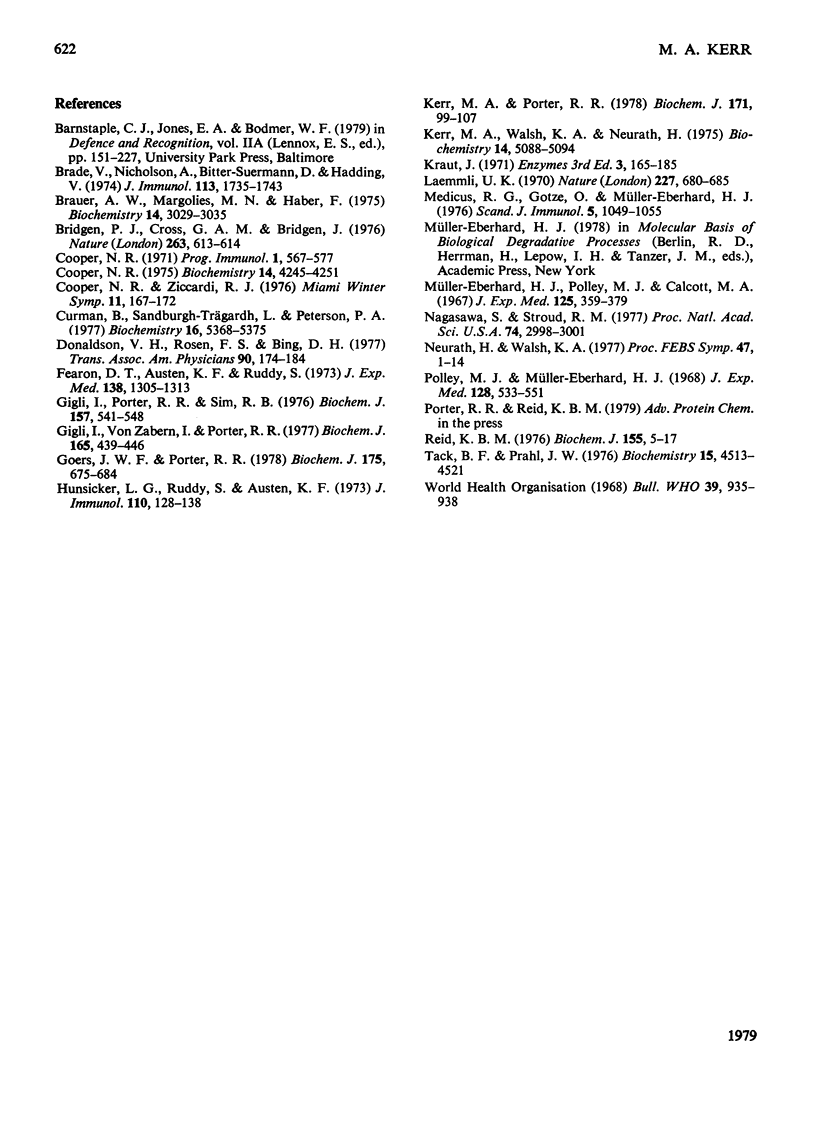
Images in this article
Selected References
These references are in PubMed. This may not be the complete list of references from this article.
- Brade V., Nicholson A., Bitter-Suermann D., Hadding U. Formation of the C3-cleaving properdin enzyme on zymosan. Demonstration that factor D is replaceable by proteolytic enzymes. J Immunol. 1974 Dec;113(6):1735–1743. [PubMed] [Google Scholar]
- Brauer A. W., Margolies M. N., Haber E. The application of 0.1 M quadrol to the microsequence of proteins and the sequence of tryptic peptides. Biochemistry. 1975 Jul;14(13):3029–3035. doi: 10.1021/bi00684a036. [DOI] [PubMed] [Google Scholar]
- Bridgen P. J., Cross G. A., Bridgen J. N-terminal amino acid sequences of variant-specific surface antigens from Trypanosoma brucei. Nature. 1976 Oct 14;263(5578):613–614. doi: 10.1038/263613a0. [DOI] [PubMed] [Google Scholar]
- Cooper N. R. Enzymatic activity of the second component of complement. Biochemistry. 1975 Sep 23;14(19):4245–4251. doi: 10.1021/bi00690a015. [DOI] [PubMed] [Google Scholar]
- Curman B., Sandberg-Trägårdh L., Peterson P. A. Chemical characterization of human factor B of the alternate pathway of complement activation. Biochemistry. 1977 Nov 29;16(24):5368–5375. doi: 10.1021/bi00643a031. [DOI] [PubMed] [Google Scholar]
- Donaldson V. H., Rosen F. S., Bing D. H. Role of the second component of complement (C2) and plasmin in kinin release in hereditary angioneurotic edema (H.A.N.E.) plasma. Trans Assoc Am Physicians. 1977;90:174–183. [PubMed] [Google Scholar]
- Fearon D. T., Austen K. F., Ruddy S. Formation of a hemolytically active cellular intermediate by the interaction between properdin factors B and D and the activated third component of complement. J Exp Med. 1973 Dec 1;138(6):1305–1313. doi: 10.1084/jem.138.6.1305. [DOI] [PMC free article] [PubMed] [Google Scholar]
- Gigli I., Porter R. R., Sim R. B. The unactivated form of the first component of human complement, C1. Biochem J. 1976 Sep 1;157(3):541–548. doi: 10.1042/bj1570541. [DOI] [PMC free article] [PubMed] [Google Scholar]
- Gigli I., von Zabern I., Porter R. R. The isolation and structure of C4, the fourth component of human complement. Biochem J. 1977 Sep 1;165(3):439–446. doi: 10.1042/bj1650439. [DOI] [PMC free article] [PubMed] [Google Scholar]
- Goers J. W., Porter R. R. The assembly of early components of complement on antibody-antigen aggregates and on antibody-coated erythrocytes. Biochem J. 1978 Nov 1;175(2):675–684. doi: 10.1042/bj1750675. [DOI] [PMC free article] [PubMed] [Google Scholar]
- Hunsicker L. G., Ruddy S., Austen K. F. Alternate complement pathway: factors involved in cobra venom factor (CoVF) activation of the third component of complement (C3). J Immunol. 1973 Jan;110(1):128–138. [PubMed] [Google Scholar]
- Kerr M. A., Porter R. R. The purification and properties of the second component of human complement. Biochem J. 1978 Apr 1;171(1):99–107. doi: 10.1042/bj1710099. [DOI] [PMC free article] [PubMed] [Google Scholar]
- Kerr M. A., Walsh K. A., Neurath H. Catalysis by serine proteases and their zymogens. A study of acyl intermediates by circular dichroism. Biochemistry. 1975 Nov 18;14(23):5088–5094. doi: 10.1021/bi00694a010. [DOI] [PubMed] [Google Scholar]
- Laemmli U. K. Cleavage of structural proteins during the assembly of the head of bacteriophage T4. Nature. 1970 Aug 15;227(5259):680–685. doi: 10.1038/227680a0. [DOI] [PubMed] [Google Scholar]
- Medicus R. G., Götze O., Müller-Eberhard H. J. The serine protease nature of the C3 and C5 convertases of the classical and alternative complement pathways. Scand J Immunol. 1976;5(9):1049–1055. doi: 10.1111/j.1365-3083.1976.tb03056.x. [DOI] [PubMed] [Google Scholar]
- Müller-Eberhard H. J., Polley M. J., Calcott M. A. Formation and functional significance of a molecular complex derived from the second and the fourth component of human complement. J Exp Med. 1967 Feb 1;125(2):359–380. doi: 10.1084/jem.125.2.359. [DOI] [PMC free article] [PubMed] [Google Scholar]
- Nagasawa S., Stroud R. M. Cleavage of C2 by C1s into the antigenically distinct fragments C2a and C2b: demonstration of binding of C2b to C4b. Proc Natl Acad Sci U S A. 1977 Jul;74(7):2998–3001. doi: 10.1073/pnas.74.7.2998. [DOI] [PMC free article] [PubMed] [Google Scholar]
- Polley M. J., Müller-Eberhard H. J. The second component of human complement: its isolation, fragmentation by C'1 esterase, and incorporation into C'3 convertase. J Exp Med. 1968 Sep 1;128(3):533–551. doi: 10.1084/jem.128.3.533. [DOI] [PMC free article] [PubMed] [Google Scholar]
- Reid K. B. Isolation, by partial pepsin digestion, of the three collagen-like regions present in subcomponent Clq of the first component of human complement. Biochem J. 1976 Apr 1;155(1):5–17. doi: 10.1042/bj1550005. [DOI] [PMC free article] [PubMed] [Google Scholar]
- Tack B. D., Prahl J. W. Third component of human complement: purification from plasma and physicochemical characterization. Biochemistry. 1976 Oct 5;15(20):4513–4521. doi: 10.1021/bi00665a028. [DOI] [PubMed] [Google Scholar]






